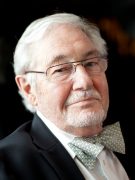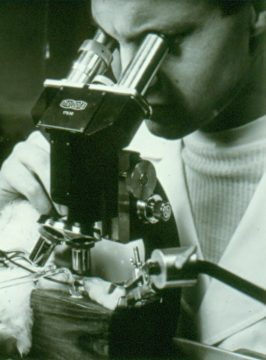RESEARCH THAT AFFECTS. Titanium has the ability to heal into bone through a process called osseointegration. The term was coined by its originator, the University of Gothenburg professor Per-Ingvar Brånemark. This process is now to be celebrated with a day of its own instituted by two large international organizations.
Two organizations, the European Academy of Osseointegration (EAO) and the American College of Prosthodontics (ACP), decided that the First Global Osseointegration Day should fall on May 3, 2021, and be celebrated annually thereafter. The date was chosen because it is the birthday of Per-Ingvar Brånemark, who died in 2014 aged 85.

“I feel as convinced as Per-Ingvar’s wife Barbro, who had the idea of holding this commemorative event, that Per-Ingvar himself would have appreciated this initiative,” says Professor Emeritus Tomas Albrektsson, who had Brånemark as his doctoral supervisor and worked closely with him at the University of Gothenburg for 30 years.
Webinar on Brånemark
The first Global Osseointegration Day will be marked with a digital get-together. After the Chairs of the two major international organizations each greet the attendees, there will be a recorded lecture by Tomas Albrektsson. Focusing on Brånemark himself, this will tell the story of the 1953 event that lit the spark of his commitment to the toothless.
“It was actually a nurse in Kristianstad who, when Brånemark was there working as a locum doctor, happened to lose her tooth prosthesis in a coffee break. Brånemark referred her to Lund University, but they were unable to help her there.”
Immune reaction
Research on osseointegration continues to this day. In the mid-2000s, it was first shown that the process is basically an immune reaction, with the body forming bone around the implant to protect the tissue. The immune system controls new formation and resorption of bone, since the cells involved (osteoblasts and osteoclasts) are parts of the immune system.

“The very first discoveries of the importance of the immune system were made a year or so before Per-Ingvar passed away. He was still very quick on the uptake, and had no problem accepting this view of his discovery. Today, of course, there’s a lot of evidence from various doctoral theses, a couple of which have already passed the public defence stage, and another due to be defended next year. The main supervisor for these doctoral students has been, and is, Ann Wennerberg, Professor of Prosthetics at the University of Gothenburg,” Albrektsson says.
Seized a chance

Brånemark’s discovery that bone integrates with titanium was something of a coincidence. In his youth, when he was working on completely different studies, he had seen how a research instrument made of titanium bonded with a rabbit bone. But what happened next was far from random. Realizing the ample opportunities afforded by the discovery, he began working intensively in wide-ranging research collaborations to refine surgical methods and materials for patient-safe dental implants. For a long time, the dental profession was highly skeptical about his technique, but in 1977 three professors at Umeå University recognized and recommended it as a form of therapy.

In time, international opposition too gave way to a triumphal march. Today, it is estimated that between 15 and 20 million osseointegrated oral implants are being inserted annually worldwide. The titanium implant has also gained a wide range of other applications — as bone-anchored hearing aids and as implants in plastic surgery and orthopedics, for example.
Permanent exhibition
Sahlgrenska Academy, too, pays tribute to Per-Ingvar Brånemark and his work, which has meant so much to so many people around the world. A permanent exhibition about Brånemark and his work, which opened in May 2010 at the Sahlgrenska Academy Medcinarberget Campus, has recently been restored and supplemented. This exhibition also includes the artist Britt-Marie Jern’s statue of Brånemark, made in 2002.
BY: ELIN LINDSTRÖM











